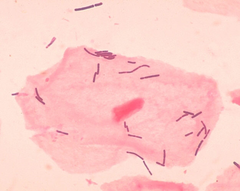Lactobacilli
Lactobacillus is a genus of Gram-positive, facultative anaerobic or microaerophilic, rod-shaped, non-spore-forming bacteria. They are a major part of the lactic acid bacteria group (i.e. they convert sugars to lactic acid). In humans, they constitute a significant component of the microbiota at a number of body sites. In women of European ancestry, Lactobacillus species are normally a major part of the vaginal microbiota.
Many lactobacilli operate using homofermentative metabolism (they produce only lactic acid from sugars), and some species use heterofermentative metabolism (they can produce either alcohol or lactic acid from sugars). They are aerotolerant despite the complete absence of a respiratory chain. This aerotolerance is manganese-dependent and has been explored (and explained) in Lactobacillus plantarum. Many species of this genus do not require iron for growth and have an extremely high hydrogen peroxide tolerance.
The genomes of Lactobacillus are highly variable, ranging in size from 1.2 to 3.3 Mb (megabases). Accordingly, the number of protein-coding genes ranges from 1,100 to about 3,200 genes.
Lactobacillus contains a wealth of compound microsatellites in the coding region of the genome, which are imperfect and have variant motifs.
The genus Lactobacillus currently contains over 180 species and encompasses a wide variety of organisms. The genus is polyphyletic, with the genus Pediococcus dividing the L. casei group, and the species L. acidophilus, L. salivarius, and L. reuteri being representatives of three distinct subclades. The genus Paralactobacillus falls within the L. salivarius group. In recent years, other members of the genus Lactobacillus (formerly known as the Leuconostoc branch of Lactobacillus) have been reclassified into the genera Atopobium, Carnobacterium, Weissella, Oenococcus, and . More recently, the Pediococcus species P. dextrinicus has been reclassified as a Lactobacillus species. According to metabolism, Lactobacillus species can be divided into three groups:
...
Wikipedia

